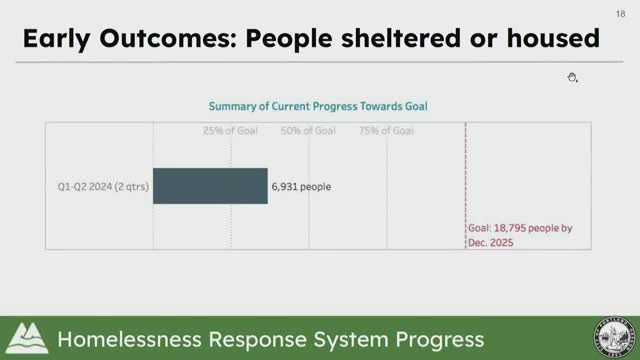Housing initiative surpasses goals while addressing racial disparities
October 08, 2024 | Multnomah County, Oregon
This article was created by AI summarizing key points discussed. AI makes mistakes, so for full details and context, please refer to the video of the full meeting. Please report any errors so we can fix them. Report an error »

In a recent government meeting, officials reported significant progress in their efforts to address homelessness, having sheltered or housed over 69,100 individuals in the past two quarters. This achievement positions them well on track to meet their goal of providing shelter or housing for an additional 27,100 people by the end of 2025, which would represent a substantial increase compared to the baseline established in the two years prior to the Homelessness Response Action Plan (HRAP).
The data indicates that the individuals sheltered or housed thus far account for 37% of the total target. However, officials acknowledged challenges in meeting their second goal, which aims to shelter or house priority populations at rates that reflect their presence in the unsheltered community. Notably, while they are meeting or exceeding this goal for most demographics, there remains a disparity for individuals identifying as Black or African American, who represent approximately 21% of those sheltered compared to 23% of the unsheltered population.
To address these disparities, the joint office is expanding culturally specific sheltering resources, which officials believe will help improve outcomes in the coming quarters. Additionally, while the goal to increase exits from adult shelters to 41% by the end of 2025 has not yet been met—currently sitting at 23%—officials noted that new programming aimed at enhancing these outcomes is just beginning to roll out.
On a positive note, the retention rate for individuals in permanent supportive housing has exceeded expectations, with 82% of participants maintaining housing stability for two years post-placement, surpassing the 75% goal.
Officials encouraged the public to monitor ongoing progress through the performance dashboard available on their website, emphasizing their commitment to using data to inform and adjust their strategies moving forward.
The data indicates that the individuals sheltered or housed thus far account for 37% of the total target. However, officials acknowledged challenges in meeting their second goal, which aims to shelter or house priority populations at rates that reflect their presence in the unsheltered community. Notably, while they are meeting or exceeding this goal for most demographics, there remains a disparity for individuals identifying as Black or African American, who represent approximately 21% of those sheltered compared to 23% of the unsheltered population.
To address these disparities, the joint office is expanding culturally specific sheltering resources, which officials believe will help improve outcomes in the coming quarters. Additionally, while the goal to increase exits from adult shelters to 41% by the end of 2025 has not yet been met—currently sitting at 23%—officials noted that new programming aimed at enhancing these outcomes is just beginning to roll out.
On a positive note, the retention rate for individuals in permanent supportive housing has exceeded expectations, with 82% of participants maintaining housing stability for two years post-placement, surpassing the 75% goal.
Officials encouraged the public to monitor ongoing progress through the performance dashboard available on their website, emphasizing their commitment to using data to inform and adjust their strategies moving forward.
View full meeting
This article is based on a recent meeting—watch the full video and explore the complete transcript for deeper insights into the discussion.
View full meeting
